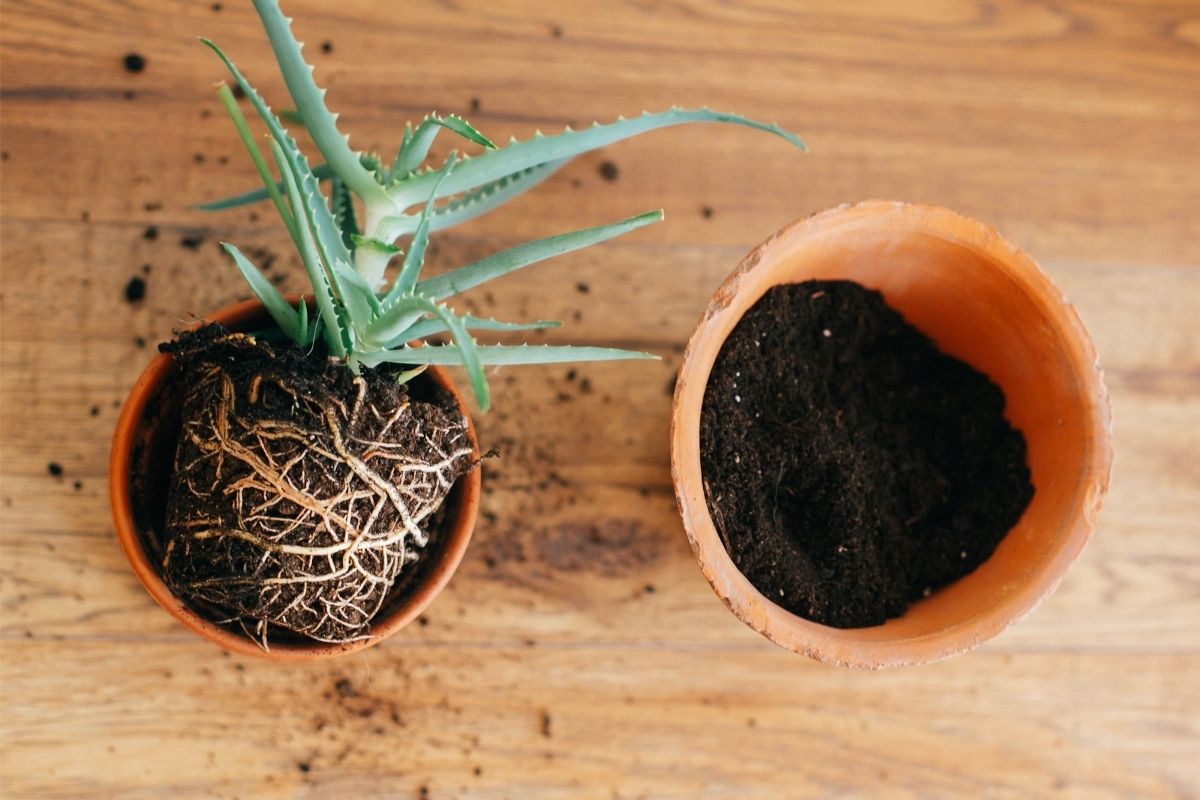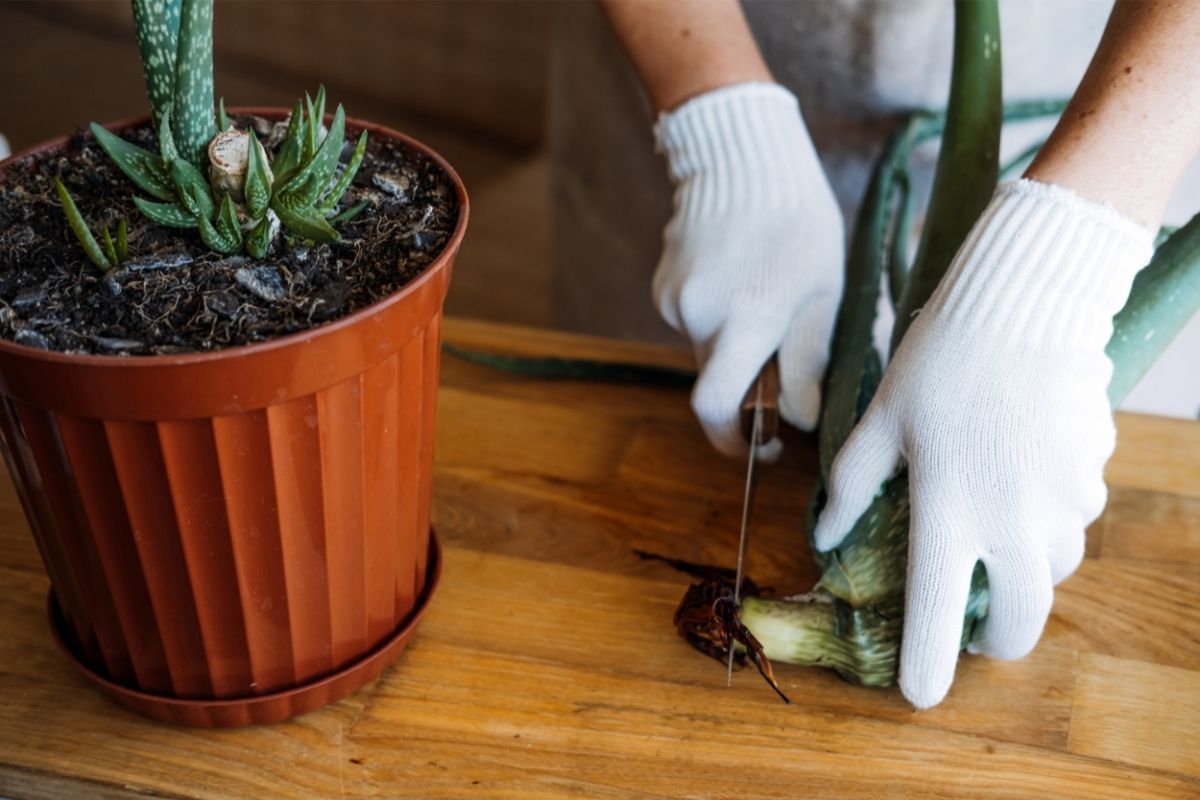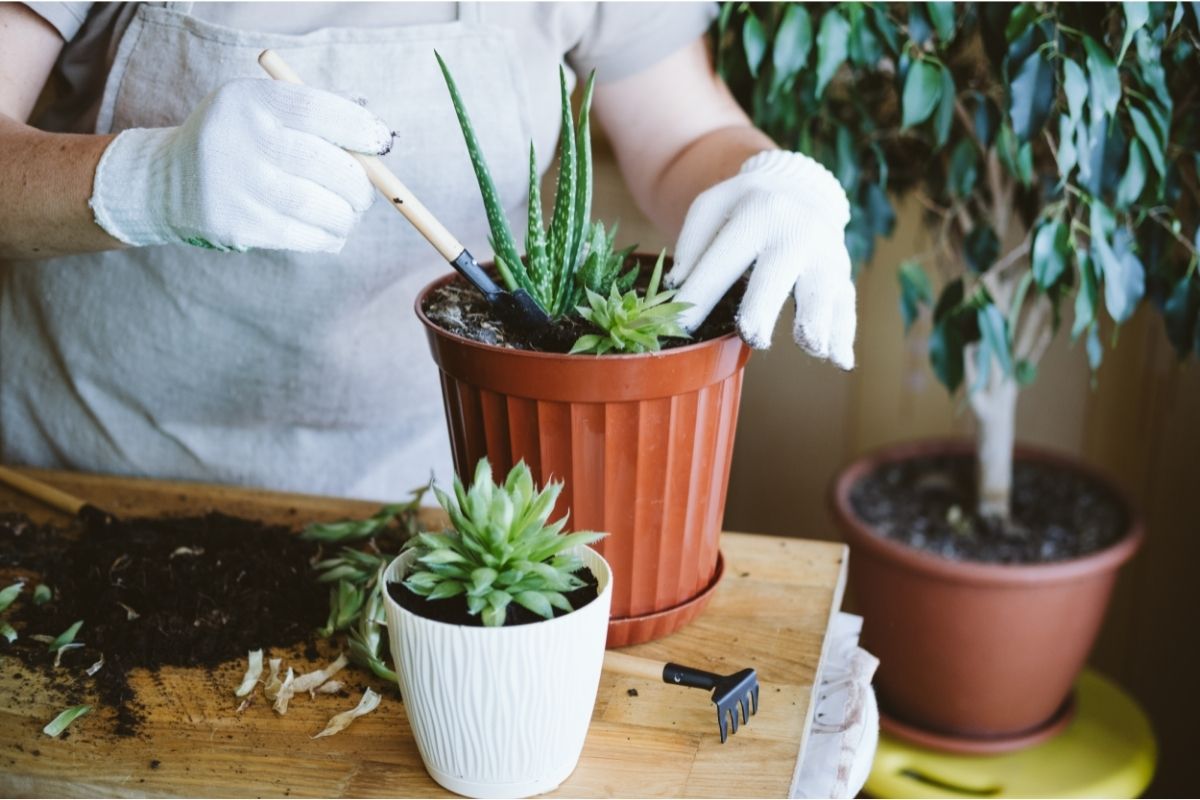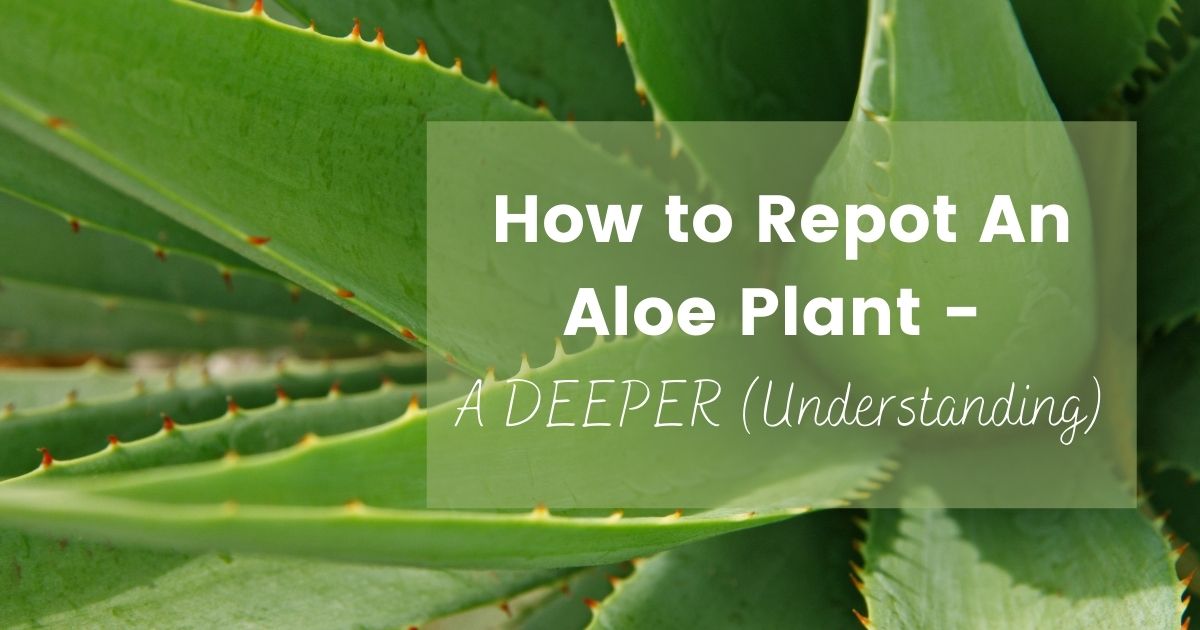What are Aloe Plants?
If you grow the aloe, you need to be conversant with how to repot an aloe plant. But what is an aloe plant? It is a succulent plant belonging to the aloe genus. The plant has thick, greenish, fleshy leaves that fan out from the plant’s primary stem and is stemless or have a very short stem. Sharp points serrate the leaf’s edge.

How to Repot an Aloe Plant
Prepare Your Pot
Place a tiny piece of screen over the drainage hole after giving the new pot a short rinse (or a good scrub if it’s a pot you’ve used before) and allow it to dry completely; this will keep the soil from spilling out the bottom and allow water to flow correctly. A doubled-up piece of paper towel or newspaper will suffice in a pinch. However, these will degrade over time.
Prepare Your Plant
Remove the aloe vera plant from its current container and gently brush away any excess dirt from the roots. Be careful not to damage the roots. Remove any pups from your plant right away.
If your plant has a very tall, spindly stem that won’t fit in the container, you can partially clip it off. Note that this is a dangerous procedure that could result in the plant’s death. To trim the stem, cut off a portion of it, leaving as much of it on the plant as feasible.
After that, set the naked plant in a warm area with indirect light. A callous will form over the wound within a few days.
Plant Your Aloe
Place the plant in the soil after filling the pot with a well-draining potting mix about a third of the way. Fill in soil around the plant, leaving at least 3/4 inch (1.9 centimeters) of space between the top of the soil and the rim of the pot. The aloe plant’s bottom leaves should also be barely above the ground. It is not advisable to water aloe vera after planting.
Ignore Your Plant (Temporarily)
After you’ve planted your aloe in its new pot, wait at least a week before watering it. This will reduce the risk of rot and give the plant more time to grow new roots. Then, keep the plant warm and in bright but indirect light until it appears rooted and happy.
Aloe Transplanting in the Open Air
If you wish to transfer your aloe plant outside, use a spade to dig a circle in the soil for its roots. Lift the plant out of the ground using the shovel. If your aloe is exceptionally huge and you want to divide pups, you may need to pull the roots apart with the spade. Transfer your plant(s) to a new hole in the ground or, if desired, into a container.
How to Take Care of Aloe Vera Plants
Lighting
Place in bright, indirect sunlight or artificial light if possible. A window facing west or south is preferable. Low-light aloes are prone to becoming leggy.
Temperature
Aloe vera thrives in temperatures ranging from 55 to 80 degrees Fahrenheit (13 to 27 degrees Celsius). Most homes and apartments have optimal temperatures. You can leave your plant outside without issue from May through September but put it back inside if the nights are cold.
Fertilizing
Fertilize sparingly (once a month or less) and only in the spring and summer with a balanced houseplant formula blended at 1/2 strength.
How Often to Water Aloe
- Watering aloe vera is the most challenging aspect of keeping the plant healthy. Although the aloe is a succulent plant that thrives in arid climates, its thick leaves require adequate water.
- Deeply water aloe vera plants only once or occasionally. In other words, after watering, the soil should feel damp, but let it dry out before watering again. The plant’s roots can rot if the soil is kept too moist.
- Allow the top third of the potting soil to dry out between waterings to avoid overwatering your plant. Let the top 2 inches (5 centimeters) of potting soil dry out before watering again. For example, if you keep your plant in 6 inches (15 centimeters) of potting soil (test the soil’s dryness with your finger.)
- Water your aloe plant every two to three weeks in the spring and summer and even less frequently in the fall and winter. When watering in the fall and winter, one rule of thumb is to increase the duration between waterings (compared to your summer watering schedule). To put it another way, if you water every two weeks during the summer, you should water every four weeks throughout the winter.
- Some surplus water may flow out the bottom of the pot during watering. Allow the pot to soak in water for as long as you can to allow the soil to absorb as much water as possible. Wait for 10 to 15 minutes before draining any remaining water.
Is Aloe a Succulent?
Yes, it very certainly does. The aloe vera plant is succulent!
It ticks all the boxes of succulent plant inclinations, from the leaves to its origin; thus, the optimum conditions it may thrive in. The plant’s leaves are thick and fleshy, ideal for a plant native to the Arabian Peninsula’s most arid climate. Its other natural lands in the Northern and Southern parts of South Africa have the same dry soil characteristics.
As a result, taking care of a houseplant is quite similar to taking care of a standard succulent houseplant. Nothing too strenuous. Paying too much attention to an aloe vera plant, especially when it comes to water, is a simple way to kill it. Watering your plant should be done with caution and only when necessary.
How to Plant Aloe Vera
Before you get to know how to plant aloe vera, do the following:
- It’s critical to select the appropriate container. A terra-cotta or similarly porous pot is ideal, as it will enable the soil to dry appropriately between waterings and keep the plant from tipping over. It’s also possible to use a plastic or glazed pot to hold more moisture.
- If you’re looking for a container, be sure it includes at least one drainage hole in the bottom. This is important because the opening will allow any extra water to drain. Although aloe vera plants are hardy, a lack of sufficient drainage can lead to rot and wilting, the most common cause of death for this plant.
- Choose a container that is roughly the same width as it is deep. Choose a deep container for you to plant the entire stem under the soil if your aloe plant has one.
- Because aloe vera plants are succulents, use a potting mix designed for cactus and succulents that drain well. Do not use gardening soil. Instead, use perlite, lava rock, bits of bark, or all three in an excellent combination.
- It is not essential to add a layer of gravel, clay balls, or any other “drainage” material to the bottom of the pot. This takes up space that the roots could otherwise use. It’s enough to have a drainage hole!
Planting
Aloe vera is a popular and straightforward plant to grow if you know how much water and sun to give to simulate the hot region in which it thrives. Unfortunately, you cannot propagate the aloe plant from a leaf cutting, which is unusual for a succulent. Instead, propagate it by removing younger clone plants from the base of the parent plant or the joint root system.
Aloe vera plants are simple to propagate because they produce plantlets or “pups” that you may gently remove to make a new plant.
Each plantlet will grow a root system of its own. Wait until the pups are at least 2 to 3 inches (5 to 7 centimeters) tall before removing them, and be sure to remove the new root system with each pup. Be sure not to damage the parent plant’s roots. Plant each pup in a small pot and lightly water it before allowing the dirt to dry thoroughly before watering it again.
When there isn’t much place for roots to spread, the plant will typically create more new shoots. If the parent plant becomes bland and weak due to the support, move it to a bigger pot.
Tips for Aloe Plant Care Indoor
Begin by planting your aloe plant in a well-drained planter. The root ball should be 1 to 2 inches (2.5 to 5 centimeters) larger than the pot’s diameter.
Place your aloe plant in a bright, indirect light source. Aloe might become sunburned if you expose it to too much light too quickly. If your aloe plant is sunburned, the white or light brown discoloration will contrast with the green foliage. The hue of the leaves will not change once burned.
Aloe is vulnerable to extreme temperature changes. In the winter, keep the plant away from drafty doorways and vents. Between waterings, allow the soil to dry out. Before watering, test the soil with your finger or a wooden stick to see how wet it is.

When to Transplant Aloe Plants
One of the many qualities that make the aloe vera such a fantastic houseplant is its proclivity for crowding. If your plant is outgrowing its container, it isn’t necessary to relocate it. However, it will ultimately get rootbound, so potting an aloe plant is an excellent idea.
If your aloe is starting to develop pups, it’s also a good idea to repot it. These are smaller offshoots of the mother plant that connect to the central root system yet survive as whole plants independently. It’s time to transfer your primary aloe plant if it’s starting to look skinny and droopy and if tiny pups begin surrounding it.
How to Promote Aloe Flower Growth
Occasionally, mature aloe vera plants produce a tall flower spike, known as an inflorescence, from which dozens of tubular yellow or red blossoms emerge. This adds a new level of interest to the already beautiful aloe!
Unfortunately, aloes kept as houseplants rarely blossom because the plant requires nearly ideal conditions to create flowers: plenty of sunshine, plenty of water, and the correct temperature range. Therefore, aloe blossoms are usually cultivated outdoors year-round in warm climates due to these needs (mainly lighting).
To give your aloe the best chance of flowering, do the following:
- Give it as much light as possible, particularly in the spring and summer. When temperatures are over 70 degrees Fahrenheit (21 degrees Celsius), keep them outside in the full sun during the summer. Bring the aloe indoors if the temperature drops below 60 degrees Fahrenheit (16 degrees Celcius) at night.
- Ensure the plant gets just enough water to keep it from drying out completely, but not so much that it drowns! If you maintain the plant outside, ensure summer rains don’t regularly soak it.
- In the fall and winter, give your aloe an appropriate dormant time. Aloes bloom in the late winter or early spring, so allowing them to rest with less frequent watering and cooler weather may encourage them to blossom.
- If it still doesn’t flower, don’t be surprised. Despite best attempts, indoor conditions aren’t optimal for most aloes, so don’t be shocked if yours refuses to blossom!
Pests and Diseases Associated with Aloes
Aloe species are subject to some of the most serious plant diseases in the succulent plant world; let us look at the illnesses that affect Aloes, as well as techniques to prevent and treat them:
Aloe Cancer
Aloe cancer, commonly known as Witches’ Broom, is a highly contagious viral infection. Mites spread aloe cancer, which forms ugly growths. Unfortunately, the most effective cure for this disease is to kill the plant. In the case of uncommon aloes, cut out the affected sections, but isolate the plant because it may likely infect the nearby aloes.
White Scale or Aloe Scale
Aloe scale, also known as white scale, is white sapsuckers. The white scale begins as a bit of infection on aloe leaves, but it can quickly escalate into a significant infestation that will undoubtedly result in the aloe’s demise.
Aloes and Ants
Ants do not harm aloes on their own, but when they team up with another common plant pest, such as mealybugs and aphids, they can cause severe damage. This is because ants and aphids have a symbiotic connection in which the ants guard the mealybugs in exchange for honeydew, a sticky sweet liquid excreted by the aphids.
Because aphids feed on sap, they can spread deadly infections amongst aloes, and because they puncture the plant, they can cause the plant to decay if left unchecked. This is often the case because they hide between the leaves where they are not visible.
It’s a good idea to check your aloes for these pests now and again, as they’re typically only spotted after the rosette collapses due to rot.
Rot
Humans are the most common cause of rot in aloes, as unskilled growers tend to overwater them. However, other pests, such as mealy bugs, aloe beetle, and others, can also cause decay. Use a clean, sharp knife to cut away the afflicted portions and then apply a systemic fungicide to treat aloe rot.
Allowing the soil to dry between waterings is an excellent rule to follow when watering your aloes. This will help keep your aloes from rotting.
Aloe Beetle (Snout Beetle)
The snout of adult beetles feeds on aloe leaves, and circular lesions typically indicate their presence with a transverse slit in the center. Snout beetles deposit their eggs near the base of aloe leaves, and once the larvae have hatched, they dig into the stem immediately below the crown, causing the plant to die.
The Different Aloe Vera Varieties
Aloe species that are particularly appealing include:
- Aloe Variegata (Tiger or Partridge-Breasted aloe): Short, smooth leaves with irregular white stripes distinguish this tiny aloe.
- Lace aloe (aloe aristata) is a tiny plant with sharply saw-toothed leaves that are white-spotted.
- Aloe Glauca (blue aloe): A bigger aloe with silver-blue leaves

What to Do With Aloe Vera After Harvesting
Now that you have information about the aloe plant, what do you do with it after harvesting? First, remove a mature aloe vera leaf from the plant and cut it lengthwise to benefit from the plant’s soothing effects.
Squeeze the gel from the leaf. Apply it to your burn, or place the opened leaf on top of the afflicted area, gel-side down. Do not consume the gel as it can cause nausea and other harmful side effects.
